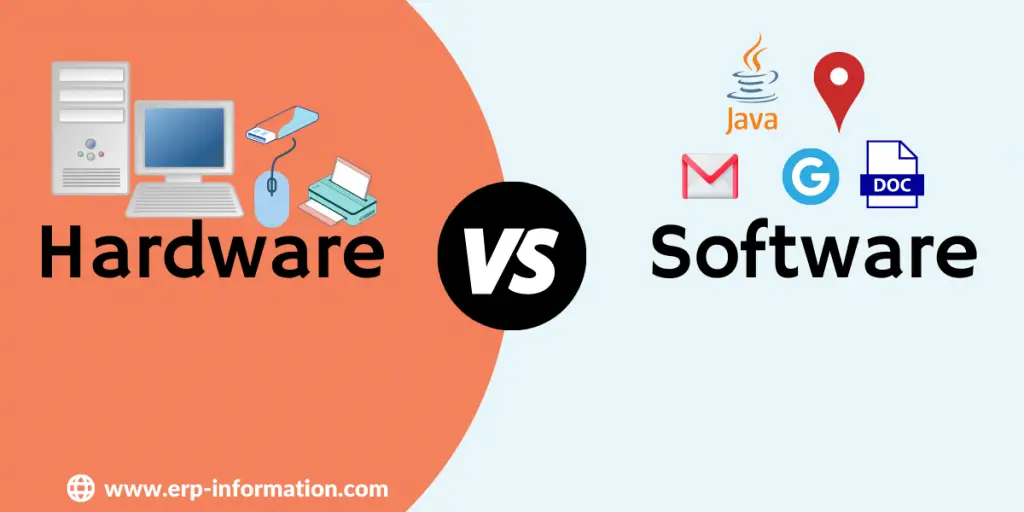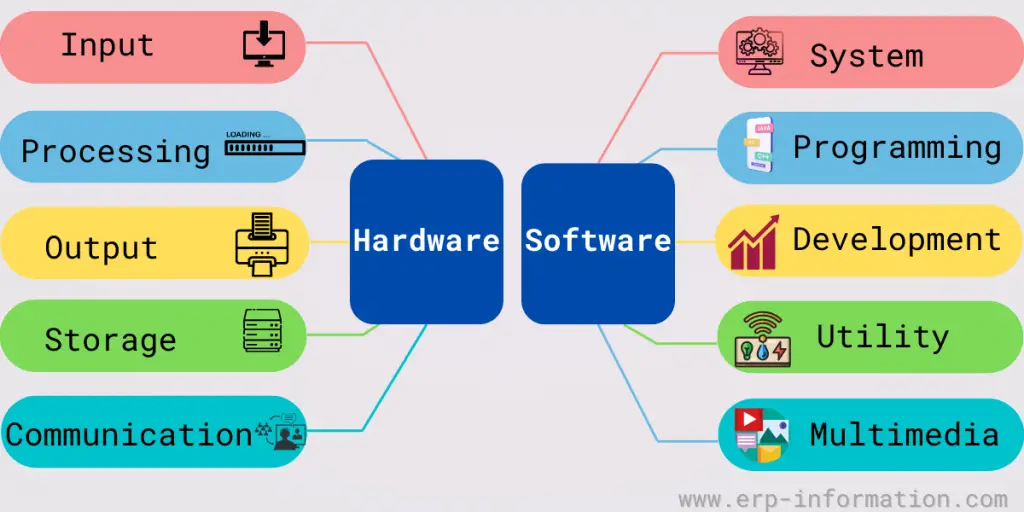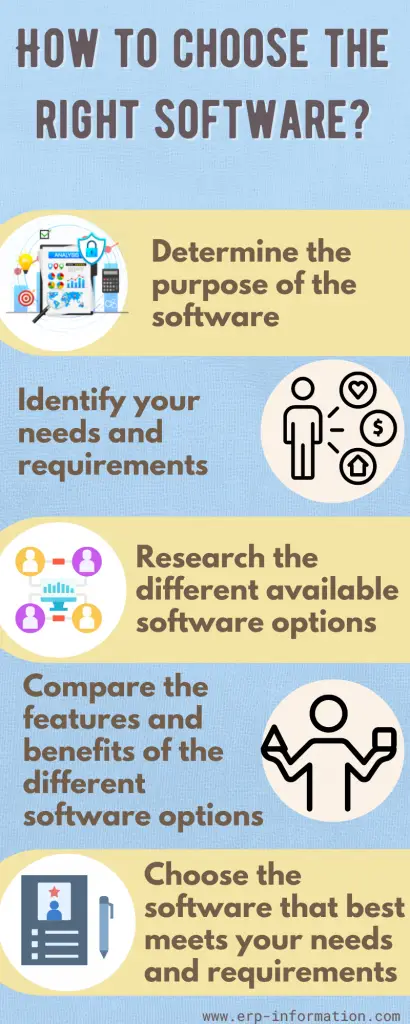
People often need help understanding the terms hardware and software and also the differences between hardware and software, leading to confusion about what they need.
There is much talk about hardware and software in business, technology, and education. But what do these terms mean?
This blog post will explore hardware vs software and discuss some examples, features, and types of hardware and software. It will also examine the steps for selecting the right system.
What is Hardware?
It is the physical component of a computer system. It is typically installed on a computer using peripheral devices that connect to the main system unit via ports or buses.
These components work together to perform computing tasks and provide users with an interface for interacting with the digital world.
Examples of Hardware
- CPUs
- Motherboards
- RAM
- Hard drives
- Solid state drives
- Video cards
- Sound cards
- Input devices (keyboards, mouse, Etc.)
- Output devices (monitors, printers, Etc.)
- Networking components (modems, routers, Etc.)
Features of Hardware
The ability to
- Store data and programs
- Process data
- Receive input from devices
- Send output to devices
- Connect to other devices
- Run software programs
What is Software?
Software is the programs and data stored on a computer’s hard drive. It is typically installed on a computer using an installer program.
It also refers to instructions or programs that tell a computer what to do. It is a general term encompassing all computer programs, including applications, utilities, and operating systems.
The software can be broadly categorized into two types.
System software: This is the software that runs the computer’s hardware and manages system resources. This includes operating systems, device drivers, firmware, and utility programs. Examples of system software include Microsoft Windows, macOS, Linux, and Unix.
Application software: This is designed to perform specific user tasks or applications. This includes word processors, spreadsheets, web browsers, photo and video editing, and gaming software. For example, it includes Microsoft Office, Adobe Photoshop, Google Chrome, and Minecraft.
Examples of the Software
- Operating systems (Windows, macOS, Linux, Etc.)
- Application programs (Word processors, web browsers, Etc.)
- Data files (Images, music, documents, Etc.)
Features of Software
The six main features of the software are as follows:
- First, it enables users to create and edit text documents.
- Second, it provides a wide range of fonts and colors.
- Third, it supports different file formats, such as DOC, DOCX, and PDF.
- Fourth, it allows users to insert images and other multimedia objects into the document.
- Fifth, it enables users to collaborate with others in real time.
- Finally, it provides a wide range of templates.
Types of Hardware and Software
Types of Hardware
Computing hardware can generally be divided into five types: input, processing, output, storage, and communication.
Input
Input devices allow a user to provide information to the computer systems. The common input device is the keyboard. Other input devices include the mouse, trackball, joystick, scanner, and digital camera.
Processing
Processing circuitry transforms data into information that the computer can use. Central processing units (CPUs), called microprocessors, are the primary type of processing circuitry. Some computers also include graphics or video processors to enhance images on the screen.
Output
Output devices present information to a user in a usable form. The most common output device is the monitor or display screen. Output devices also include printers, plotters, and Braille output devices.
Storage
Storage devices hold data or programs permanently or semi-permanently. Storage devices include hard drives, floppy disks, and removable media such as CD-ROMs and DVDs.
Communication
Communication devices enable computers to exchange information with other computers or devices. Communication devices include modems, network cards, and bridges.
Types of Software
Types of software can typically be divided into categories: system software, programming software, development software, utility software, and multimedia software.
System software
System software is a type of software that manages and controls computer hardware and provides a platform for running application software. This includes the Windows operating system and the macOS. These basic programs run your computer and allow you to interact with it.
Programming software
This helps you write code for applications or websites. Popular examples include Microsoft Visual Studio and Adobe Dreamweaver.
Development Software
This is used for more advanced coding and building applications from scratch. It often includes features for debugging code, compiling applications, and managing project files. Some popular examples include Apple Xcode and Microsoft Visual Studio Code.
Utility software
This is a broad category of programs that includes disk defragmenters, system cleaners, and virus scanners.
Multimedia software
This is used for working with media files such as images, audio, and video. Popular examples include Adobe Photoshop and Apple iTunes.
Hardware vs Software
| Hardware | Software | |
| Hardware | It is a physical component of a computer system | It is a set of instructions that informs the hardware what to do. |
| Virus attack | Viruses cannot infect hardware. | A virus is malware that can replicate itself and spread to other computers. |
| Building | It is designed using schematics and circuits. | It is developed using programming languages. |
| Recovery | Hardware that is damaged or lost cannot be recovered. | If software becomes corrupt or lost, it can usually be recovered from backups or reinstalled. |
| Durability | It is durable and can last for many years. | It may become outdated or need to be upgraded regularly. |
| Transfer | It must be physically moved. | It can be transferred to another computer by copying it. |
| Language type | It can understand only low-level language (zeros and ones). | It is written in high-level programming languages. |
| The reason for failure | It can fail due to physical damage or wear and tear. | It can fail due to bugs, errors, or vulnerabilities. |
| What problems occur | Problems can consist of malfunction, physical damage, or obsolescence. | Problems can include crashes, errors, or vulnerabilities. |
| The complexity of fixing the problem | It can be more difficult to fix and may require replacement parts. | It can usually be fixed by patching the code or reinstalling the program. |
| Dependency | It is not dependent on other software or hardware. | It often depends on other software or hardware ( processors and memory) to function properly. |
| Tangible | Tangible, meaning it can be touched and seen. | It is intangible. |
| Fixing cost | It can be expensive to replace or upgrade. | It is often much less costly to fix the issue or upgrade. |
| Flexibility | It is specific to the type of software it can run. | Many types of software can run on the same hardware. |
| Damage | Physical forces can damage it. | It is not as vulnerable to physical damage. |
How do you choose the right hardware?
- Firstly, you’ll need to decide what type of computer you need – a desktop, laptop, or tablet.
- Secondly, you’ll need to consider the device’s specifications, such as the processor type, amount of RAM, and storage capacity.
- When choosing hardware for a computer, it is important to consider the intended use of the system.
- For example, if you plan on using a laptop for gaming, you will need to choose components designed for high-performance gaming. Alternatively, you can choose less expensive parts if you use the computer for general use.
- Finally, you’ll need to think about the peripherals you’ll need, such as a monitor, mouse, and keyboard.
How do you choose the right software?
- Determine the purpose of the software.
- For example, if you need a word processor, choose a program with all the features you need, such as Microsoft Word or Google Docs.
- Identify your needs and requirements.
- If you need a web browser, you’ll want to choose one that is fast and has all the features you need, such as Google Chrome or Mozilla Firefox.
- Research the different available software options.
- Compare the features and benefits of the different software options.
- Choose the software that best meets your needs and requirements.
FAQs
What is the main connection between hardware and software?
Hardware and software are interconnected. The software cannot work without hardware devices, and hardware cannot do anything without software instructions. The relevant software package has to be installed to do any specific word.
Conclusion
Hardware and software are two essential components of a computer system. They serve different purposes. Hardware is the physical part of a system, while software is the programs and data that run on the hardware.
Both have a unique role to play in a computer system and are necessary for a system to function properly.

